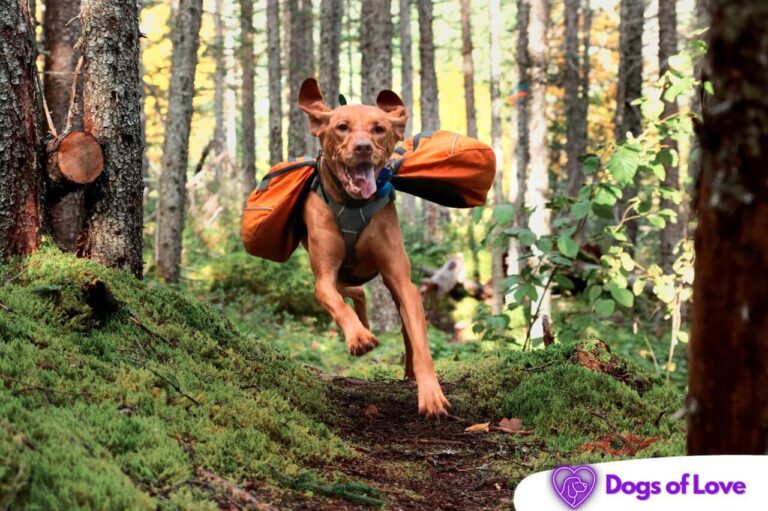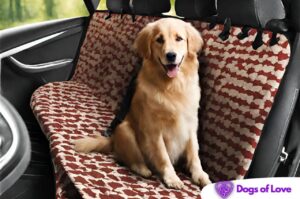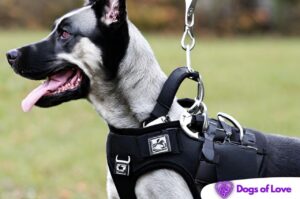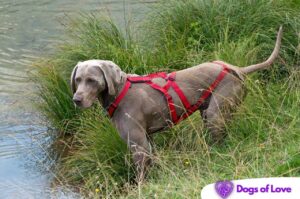Embarking on outdoor adventures with your furry companion can be an enriching experience.
Not only does it strengthen the bond between you and your dog, but it also allows them to actively contribute to the journey by carrying their load.
Teaching a dog to carry a pack, often referred to as a saddlebag, is a skill that can enhance your hiking, camping, or backpacking trips.
Beyond its practical benefits, this training process offers mental and physical stimulation for your canine friend.
However, like any training endeavor, introducing your dog to carrying a pack requires patience, positive reinforcement, and a step-by-step approach.
In this guide, we will delve into the techniques and considerations involved in training your dog to comfortably and confidently carry a pack, ensuring that both you and your four-legged companion can fully enjoy the adventures that lie ahead.

Purchase a pack (saddle bag) designed for dogs and ensure it fits your dog comfortably.
Before embarking on the journey of training your dog to carry a pack, it’s crucial to select the right equipment.
Invest in a purpose-designed dog pack, commonly called a saddlebag, to ensure your canine’s comfort and safety throughout your outdoor expeditions.
These packs are designed to distribute weight evenly and accommodate your dog’s natural movements.
When choosing a pack, consider your dog’s size, weight, and body shape.
Opt for an adjustable pack that can be customized to fit snugly but comfortably on your dog.
The pack(saddlebag) mustn’t chafe or restrict your dog’s movement.
Prioritize packs with padded straps and a breathable design to prevent discomfort during long hikes.
Taking the time to select a suitable pack(saddlebag) carefully will not only contribute to your dog’s overall well-being but also make the training process smoother as your canine companion embraces their new role as an enthusiastic pack carrier.
Initial Introduction:
The initial introduction to the pack(saddlebag) is a crucial first step in the training process.
Approach this phase with patience and a positive attitude to help your dog develop a curious and accepting mindset.
Place the pack in an environment where your dog feels comfortable and relaxed.
Allow them to sniff and investigate the pack(saddlebag) at their own pace, rewarding them with praise, treats, or their favorite toys whenever they display interest or interact with it.
Keep the experience upbeat and stress-free, ensuring your dog associates the pack with positive experiences.
If your dog seems hesitant or anxious, take a step back and give them more time to become accustomed to the new object.
This initial stage lays the foundation for a successful training journey, setting the tone for your dog’s gradual acceptance and enthusiasm for wearing and carrying their pack.
Familiarize Your Dog with Clasp Sounds:
Gradually introduce your dog to the distinct sounds of the pack’s clasps.
Begin by gently manipulating the clasps while giving your dog treats or affection to create a positive association.
As your dog becomes more comfortable, purposely make the clasp sound and reward them immediately.
This step helps your dog grow accustomed to the noise, minimizing potential apprehension and making wearing the backpack more seamless.
Empty Backpack Wear
To acclimate your dog to wearing a backpack, have them wear it empty.
Gently secure the backpack around your dog, adjusting the straps for a comfortable fit.
Allow your dog to move around freely while wearing the empty pack indoors or in a familiar outdoor space.
This initial experience helps them become accustomed to the weight, shape, and movement of the backpack, ensuring they gradually develop ease and confidence in their new role as pack carriers.
Embark on Outdoor Exploration
Once your dog is at ease wearing the empty saddlebag, it’s time to venture outdoors.
Choose a calm and familiar environment for your first outdoor excursion with the saddlebag on your dog’s back.
Keep the initial outing relatively short and engaging, allowing your dog to experience the sensation of the backpack in a real-world setting.
Walk, hike, or explore leisurely, offering encouragement and rewards to reinforce positive behavior.
This outdoor experience not only helps your dog adapt to carrying the pack in various conditions but also solidifies their understanding of their role as pack-carrying companions during your shared adventures.
Progress Gradually with Weight
Begin by placing lightweight items in the pack(saddlebag), such as soft toys or small essentials.
As your pup becomes more accustomed to the added weight, you can gradually increase it over time.
This progressive approach ensures that your dog’s muscles and confidence develop steadily, preventing strain or discomfort.
Monitor your dog’s body language and behavior during walks or hikes, and adjust the weight accordingly.
By allowing your pup to build strength and confidence incrementally, you set the stage for a rewarding journey where they can comfortably contribute to your outdoor adventures while staying happy and healthy.
Reinforce with Positive Rewards
As responsible pet owners, we all want our furry friends to be happy and healthy.
And for those of us who enjoy hiking or camping with our dogs, getting them accustomed to wearing a pack(saddlebag) can be a great way to help them feel purposeful while keeping them safe.
However, it’s important to remember that our pups are still learning, and positive reinforcement can work wonders when encouraging good behavior.
So, reward your pup every time he carries his load on a hike or a walk around the block.
This will let him know he’s doing a great job and encourage him to wear his backpack with pride and enthusiasm.
Not only will this help him stay fit, but it will also give him a sense of purpose and belonging, which are essential to his well-being.
Progressive Walks with Added Weight
Incorporate regular walks with your pup while gradually extending the distance and increasing the weight within their pack(saddlebag).
Begin with shorter walks and a manageable load, allowing your dog to adapt to the evolving challenge.
As your pup’s endurance and confidence grow, gradually extend the length of the walks and introduce slightly heavier items into the pack.
This step-by-step approach not only builds your dog’s physical stamina and develops stronger muscles but also reinforces their understanding of carrying a pack as a natural part of their outdoor routine.
Remember to monitor your dog’s comfort level and observe any signs of fatigue, adjusting the duration and weight as needed.
By embracing this gradual progression, you ensure that your pup becomes a capable and content companion on your outdoor escapades.
In conclusion
Through a blend of patience, consistent effort, and well-deserved rewards, you can transform your pup into a skilled and reliable pack-carrying companion.
Training your dog to embrace this role requires time and dedication, but the result is a partnership enriched by shared experiences and mutual trust.
Each step, from introducing the pack to embarking on outdoor adventures, contributes to your pup’s growing comfort and confidence.
By nurturing this process with positive reinforcement and unwavering support, you not only equip your dog with valuable skills but also foster a deep bond built on teamwork and adventure.








